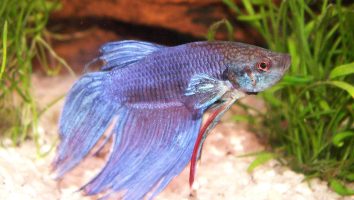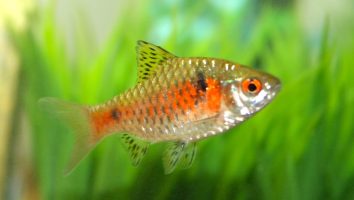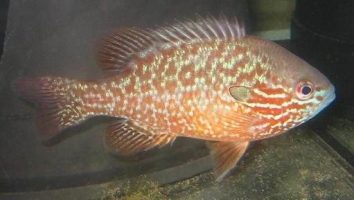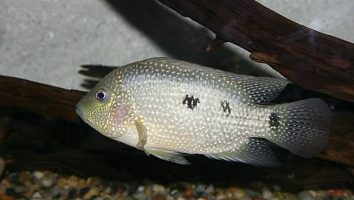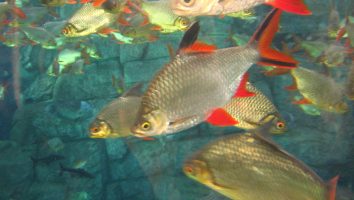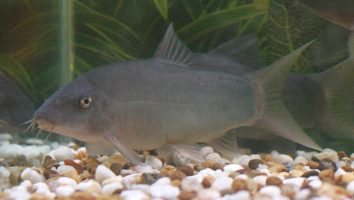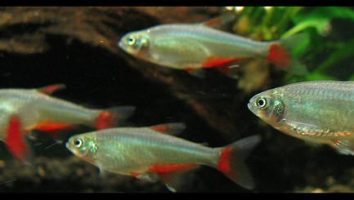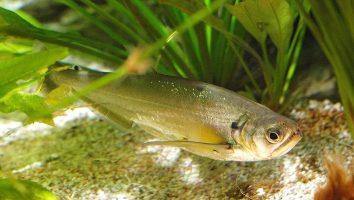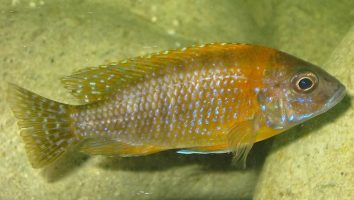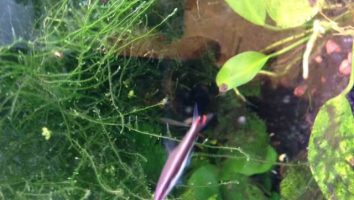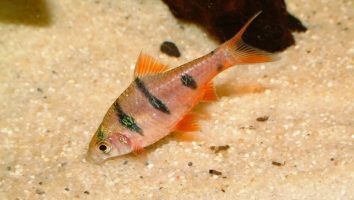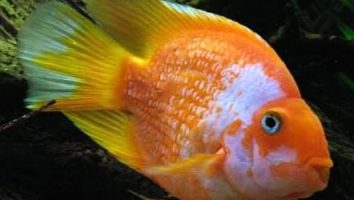Climbing perch are a freshwater fish that can be found in a variety of habitats throughout Asia.
While they’re not the most popular fish in the aquarium trade, they’re definitely an interesting species that’s worth learning about.
In this guide, we’ll teach you everything you need to know about climbing perch care. You’ll learn about their diet, tank mates, lifespan, and more!
Table of contents
Species overview
The climbing perch (scientific name: Anabas testudineus) is a type of fish that is native to various parts of Asia, including India, Bangladesh, Sri Lanka, and Malaysia.
They get their name from their ability to climb trees and other structures out of the water using their strong fins. Although this is an unusual trait, it’s actually quite helpful for them because it allows them to escape from predators and find new sources of food.
Climbing perch are very adaptable and can live in a wide range of different water conditions. They prefer slow-moving water with a lot of vegetation, but they can also survive in fast-moving water and even brackish water.
This fish is a popular choice for aquariums because it’s very hardy and can live in a wide range of conditions. They are also very peaceful and can be compatible with a wide variety of tank mates.
Appearance

The first thing you’ll notice about this freshwater fish is their long ventral fins. These fins are very thin and streamline. In fact, they’re so long that they almost touch the ground when the fish is swimming!
The ventral fins are used to help the fish climb and cling to surfaces. This is how they get their name.
The rest of the fish is pretty standard, but still unique in a lot of respects. Their body shape is long, tall, and thin with a relatively symmetrical appearance.
The bulk of their dorsal fin matches their anal fin and begins about two-thirds of the way back on the body of the fish.
Both of these fins extend back quite a way and really dwarf their caudal fin which is rather stubby by comparison. At the end of their dorsal and anal fins, you’ll also find a long thin strand of tissue.
Climbing perch have a lumpy “chin” area that leads right into their ventral fins. The ventral fins are fairly thin and begin a third of the way down their bodies.
These fish have rather planted eyes that really stand out on their heads. You’ll definitely get the impression that they’re studying you and trying to figure you out.
Lifespan
Climbing perch have a lifespan of around 3 to 5 years. However, there have been reports of them living up to 10 years in captivity.
As with any fish, their lifespan will be greatly impacted by the level of care they receive. Things like water quality, diet, and stress can all play a role in how long they live.
Size
The maximum size of a climbing perch is about 12 inches in length.
Tank
Tank Size
The recommended minimum tank size for a climbing perch is 75 gallons. If you want to keep more than one fish, you should add an additional 50 gallons for each fish.
Climbing perch are semi-aggressive fish and need a lot of space to roam. They are also known to be jumpers, so it’s important to have a tank that is covered.
Water Parameters
The water parameters for the climbing perch are actually pretty simple. They’re a tropical fish, so as long as you can maintain a consistent temperature in the mid-70s, you should be in good shape.
pH levels can range from 6.5 to 8.0, but they’re not as picky as some other species. As long as the water isn’t too alkaline or acidic, they should do just fine.
The water hardness isn’t too important either. They’re a pretty adaptable fish, so as long as the water isn’t too soft or too hard, they should be okay.
The most important thing is to avoid sudden changes in the water parameters. These fish are pretty sensitive to changes, so it’s best to make any adjustments slowly over the course of a few days.
- Water Temperature: 75°F to 82°F
- pH Levels: 6.5 to 8.0
- Water Hardness: Not too soft or too hard
- Alkalinity Levels: Not too alkaline or acidic
What To Put In Their Tank
When it comes to setting up the inside of an aquarium for Climbing Perch, there are a few things you need to take into consideration.
First and foremost, these fish are known for being incredible jumpers. If you don’t have a lid on your tank, they will find a way out. Make sure the lid is secure and has no gaps!
Since they’re such good jumpers, you also need to be aware of the water level. It should be high enough that they can’t jump out, but low enough that they can’t easily get to the top of the tank and escape that way.
Something else to consider is the fact that these fish are known for being very active. They need a lot of space to swim around, so we recommend a tank that’s at least 50 gallons.
The substrate in their tank can be pretty much anything. They’re not known for being picky eaters, so feel free to use whatever you have on hand.
As for plants, you can include them if you want, but be aware that these fish are known for uprooting them. If you do decide to go with plants, make sure they’re well secured in the substrate.
Common Diseases
There are a few potential diseases that your climbing perch could contract. Some of these are more common than others, but it’s always important to be on the lookout for anything out of the ordinary.
The most common disease that these fish experience is bacterial infection. This can occur for a number of reasons, but the most common is simply poor water quality.
If you notice your fish acting strangely or see any redness, swelling, or pus coming from their skin then you should assume that they have a bacterial infection and treat them accordingly.
The other disease that these fish are prone to is parasitic infection. This is again most commonly caused by poor water quality, but it can also be caused by the fish eating infected prey.
The most common symptom of a parasitic infection is a loss of appetite. If you notice your fish stop eating then you should check them for any other signs of illness and treat them accordingly.
As always, the best way to prevent these diseases is to simply maintain a healthy environment for your fish. Keep the water quality high and don’t overfeed them.
If you do notice any signs of illness then the sooner you act, the better. Treat them accordingly and consult your vet if the problem persists.
Behavior & Temperament
The climbing perch is a bit of an anomaly. It’s not often that you see a fish that can climb out of the water and walk on land!
Climbing perch are very curious fish. They’re always exploring their environment, looking for new things to check out. This includes venturing out of the water from time to time. They’re not afraid to leave the safety of their aquatic home and will often be seen crawling around on land.
Of course, this isn’t something they can do for long periods of time. They need to return to the water to breathe. But it’s still a pretty neat trick to see!
When it comes to temperament, climbing perch are relatively peaceful. They’re not known for being aggressive and will usually get along with other fish just fine.
Tank Mates
When it comes to finding the best tank mates for climbing perch, the first thing to consider is their natural habitat.
These fish come from slow-moving rivers and streams in Southeast Asia. The water is typically warm and murky with plenty of places to hide.
With that in mind, you’ll want to look for fish that come from similar environments. This will make it easier to recreate their natural habitat, which is important for their long-term health.
Compatible tank mates for climbing perch include:
- Betta Fish
- Gouramis
- Loaches
- Tetras
- Rainbows
- Barbels
- Danios
Breeding
The climbing perch is a fairly easy fish to breed as long as you provide them with the right habitat. They are Egg Scatterers, so the female will lay her eggs and the male will fertilize them.
You don’t need to do anything to trigger spawning. The fish will do it on their own when they’re ready.
The female will lay her eggs in a plant or some other type of debris. Once the eggs have been laid, the male will fertilize them.
You don’t need to do anything to trigger spawning. The fish will do it on their own when they’re ready.
The female will lay her eggs in a plant or some other type of debris. Once the eggs have been laid, the male will fertilize them.
After the eggs have been fertilized, the male will guard them. He will also fan them with his fins to keep them oxygenated.
The eggs will hatch in about a week. You can then remove the male and begin feeding the fry. They will eat things like baby brine shrimp and microworms.
Conclusion
The climbing perch is a great fish for anyone looking for something a little different. They have a cool appearance and can be a lot of fun to watch.
They’re also not very difficult to care for, which is always a bonus.
If you’re thinking about getting a climbing perch, we say go for it! You won’t be disappointed.

